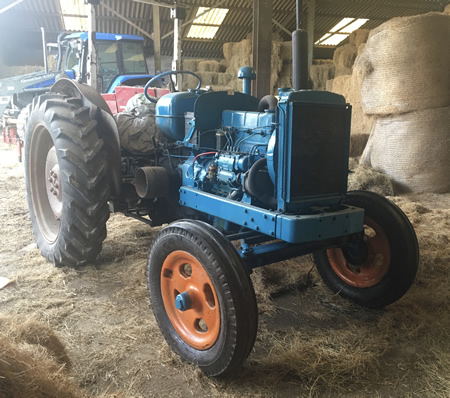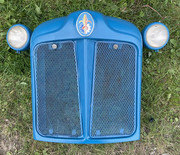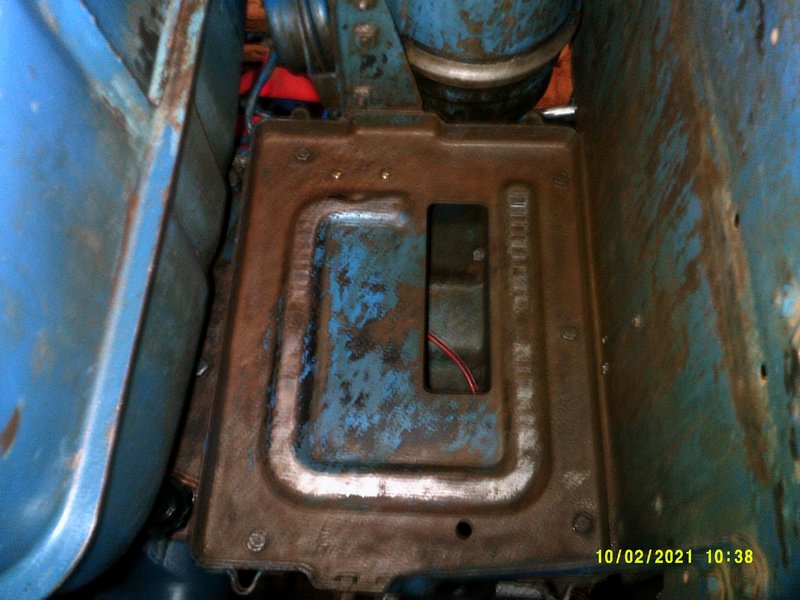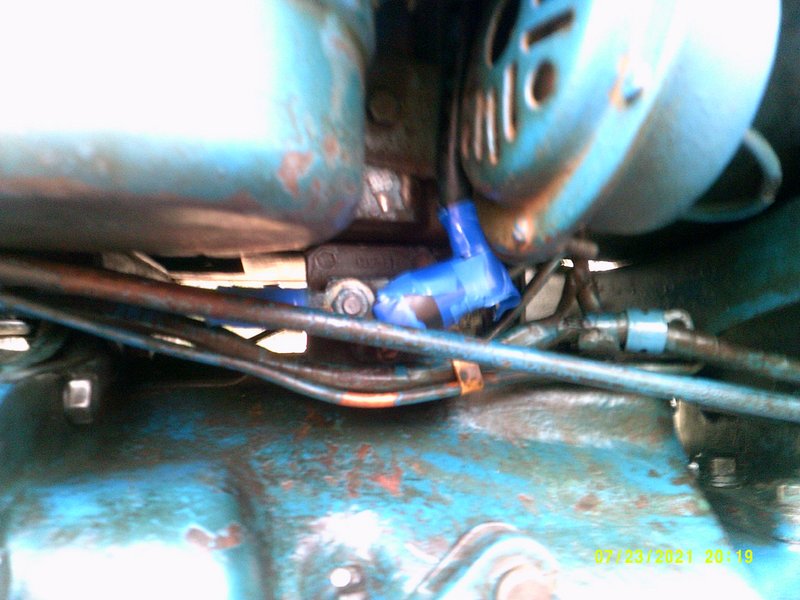New user, new project
Re: New user, new project
I found this video (not mine) of it doing so.
Sandy
https://www.youtube.com/watch?v=Lhvd8yj ... MarkCasely
Sandy
https://www.youtube.com/watch?v=Lhvd8yj ... MarkCasely
Re: New user, new project
What the video shows is not so much the governor responding with the diaphragm and rack moving the pumping elements, but more so the elements minutely moving the rack and diaphragm due to vibration and bounce, this is what you normally see.
1946 E27N, 1952 Major Diesel, 1959 Power Major, 1962 Dexta, 1962 Super Dexta, 1963 Super Dexta NP, 1964 Super Major NP, 1965 Super Dexta 3000, 1966 Major 4000, 1967 3000 PF, 1994 5640,plus Basildon built NH.
Re: New user, new project
Getting some new front tires and finishing painting axels. Then new photos before replacing bonnet. Quick question. Can’t seem to find the original location to secure starter solenoid. Can I have a few pics of where you guys have yours in relation to air filter and fuel tank. Thanks.
Re: New user, new project
Re: New user, new project
Thank you, I had seen those holes but thought the clearance looked tight and was worried about shorting, will have to make sure well insulated......
Re: New user, new project
Don't insulate those holes, or the solenoid will not have an earth and it won't work.
Sandy
Sandy
Re: New user, new project
Front-end Friday now the wheels are done....

Bonnet next.....

Bonnet next.....
Re: New user, new project
OK, so not worked on this for a while so thought I should finish the front end...

Bonnet next then I can start on the back end.... gonna need some heavy lifting equipment again....

Bonnet next then I can start on the back end.... gonna need some heavy lifting equipment again....
Re: New user, new project
Neat work. Better take more time and get it right then hurry hurry to do it all over again and again
Best regards
Emiel
N 1937, E27N 1948, 8N 1949, E27N 1950, E1A Diesel 1953, E1ADKN PP 1956, Dexta 1959, NH Clayson M103 1964
Emiel
N 1937, E27N 1948, 8N 1949, E27N 1950, E1A Diesel 1953, E1ADKN PP 1956, Dexta 1959, NH Clayson M103 1964
Re: New user, new project
Interesting comment from Billy about injector failure -- plus, of course, also the responses from Shepp and Hywell.
But, I wonder, have all three missed the salient point -- the firing order -- calculated to place the least stress on the axis of rotation of the crankshaft.
Pavel
But, I wonder, have all three missed the salient point -- the firing order -- calculated to place the least stress on the axis of rotation of the crankshaft.
Pavel
Re: New user, new project
If the firing order were wrong the engine wouldn't run, what could be checked is the phasing in the pump, but that's an expensive job, it can be done at a later date if required without too much fuss. I don't know what this Major sounds like running on all four, so I can't say whether it's ok or not.
Sandy
Sandy
Re: New user, new project
Sorry Billy; that was not what I was referring too but rather your words --' Don't run like that for longer than you need to bleed the injectors as it overloads the next cylinder (no. 4)' It is not a cylinder or piston that one should worry about but rather the now [as you have cited] unequal pressure/stress placed on the adjacent crankshaft journals. A firing order tends to blend the rocking action of the crankshaft away from a straight 1-2-3-4 series of explosions into a less damaging 1-3 or 2-4 one.
Pavel
Pavel
Re: New user, new project
I'm not now understanding your point, when I referred to the next cylinder being no. 4 it was because no.2 wasn't firing, turning 1-2-4-3 into 1-nothing-4-3. This makes the engine run at an irregular speed, as it looses speed when cylinder no.2 should be keeping it up. As a result no. 4 fires at full delivery to restore the speed, causing unequal loading to that crankpin versus the others. When the engine is at full power all four crankpins recieve the maximum force, meaning that they should all wear at the same rate. If there has been much unbalanced running the crankpin that has been taking the extra load will need new bearings earlier than the others.
Sandy
Sandy
Re: New user, new project
While I can agree that a misfiring engine may cause unwanted unbalanced loading to the crank, I must disagree with the suggestion that a misfiring engine speeds up and down as a result. As mentioned earlier, the governor reacts to maintain a steady engine speed, and is not affected by the condition or performance of individual cylinders.
Consider an engine running at 1200 rpm. My maths suggests that’s 600 firing strokes per cylinder per minute. It’s unlikely that the governor on a Major could alter the fuelling 10 times a second. Additionally, an engine has a great lump of metal at the rear of the crankshaft in the shape of a flywheel, cunningly designed to smooth out the firing pulses.
Consider an engine running at 1200 rpm. My maths suggests that’s 600 firing strokes per cylinder per minute. It’s unlikely that the governor on a Major could alter the fuelling 10 times a second. Additionally, an engine has a great lump of metal at the rear of the crankshaft in the shape of a flywheel, cunningly designed to smooth out the firing pulses.
Re: New user, new project
The flywheel is designed to get through one compression before getting accelerated, with a cylinder not firing that's two compressions, meaning a lot more has been lost before the next cylinder fires, this extra loss means that the throttle will already have to move to a faster setting.The irregular speed will also prevent slow running that would normally be easy work and as a result a fluctuating vacuum, causing the governor to oscillate to spite the damping valve as the speed changes are too much for it. The result is the well known loud knock from the cylinder that now has to do the work of the previous one as well and increased fuel consumtion and potential damage if not fixed quickly.
The long and the short of this is to do as Ford said and not run the engine if it's not firing on all cylinders (except bleeding injectors carefully).
Sandy
The long and the short of this is to do as Ford said and not run the engine if it's not firing on all cylinders (except bleeding injectors carefully).
Sandy
Re: New user, new project
A misfiring engine is not desirable, I think we’d accept.
However, i cannot agree with the comments above concerning the governor ‘ overloading’ one cylinder in an effort to maintain the desired engine speed. The manifold vacuum does not fluctuate even if one cylinder is not firing, therefore the rack in the injection pump will not, and cannot alter the fuelling on individual injectors. As I mentioned earlier, (if my calculations are correct), at a leisurely 1200 rpm, each cylinder fires 10 times a second, way beyond the ability of the governor to react and vary delivery.
As for two consecutive compression strokes allowing the engine to slow, no. In a four cylinder, four stroke engine each compression stroke is more than countered by the power stroke at another cylinder. If one is not firing, then only one is idle.
If anyone wants to experiment, run an engine with one delivery pipe slack, take off the inj pump cover and hold the rack still. It will miss, knock perhaps, but you can be sure all elements are delivering equal amounts. NO, on second thoughts, don’t do that, things could go wrong.
However, i cannot agree with the comments above concerning the governor ‘ overloading’ one cylinder in an effort to maintain the desired engine speed. The manifold vacuum does not fluctuate even if one cylinder is not firing, therefore the rack in the injection pump will not, and cannot alter the fuelling on individual injectors. As I mentioned earlier, (if my calculations are correct), at a leisurely 1200 rpm, each cylinder fires 10 times a second, way beyond the ability of the governor to react and vary delivery.
As for two consecutive compression strokes allowing the engine to slow, no. In a four cylinder, four stroke engine each compression stroke is more than countered by the power stroke at another cylinder. If one is not firing, then only one is idle.
If anyone wants to experiment, run an engine with one delivery pipe slack, take off the inj pump cover and hold the rack still. It will miss, knock perhaps, but you can be sure all elements are delivering equal amounts. NO, on second thoughts, don’t do that, things could go wrong.




